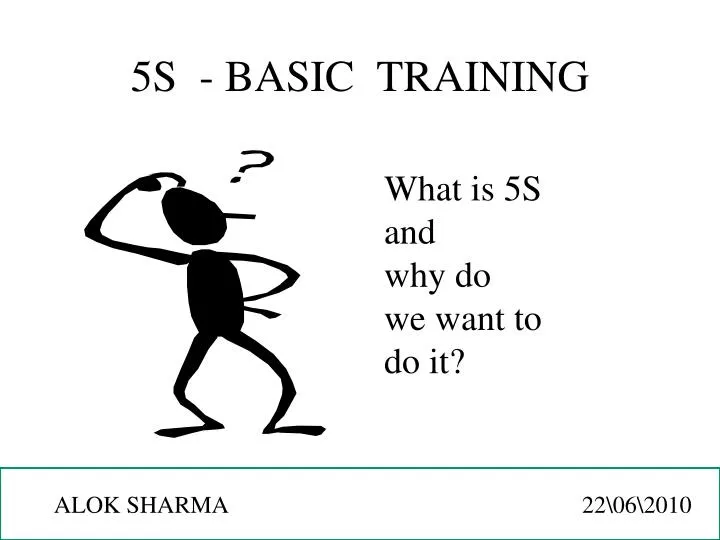

5S - BASIC TRAINING
Sep 27, 2014
27.02k likes | 47.53k Views
5S - BASIC TRAINING. What is 5S and why do we want to do it? . ALOK SHARMA 2262010. What is 5S ?. Seiri – Sort (housekeeping) Seiton – Systematic Arrangement (workplace organization)
Share Presentation
- seiri sorting
- broken items
- functional storage
- eliminating unwanted items
- respiratory system sorts oxygen

Presentation Transcript
5S - BASIC TRAINING What is 5S and why do we want to do it? ALOK SHARMA 22\06\2010
What is 5S ? • Seiri – Sort (housekeeping) • Seiton – Systematic Arrangement (workplace organization) • Seiso – Shine (Cleanup) • Seiketsu – Standardize • Shitsuke – Sustain (Self Discipline)
What is 5S ? 5S represents 5 disciplines for maintaining a visual workplace (visual controls and information systems). These are foundational to Kaizen (continuous improvement) and a manufacturing strategy based "Lean Manufacturing" (waste removing) concepts. 5S is one of the activities that will help ensure any company’s survival.
5S 1. Sort - All unneeded tools, parts and supplies are removed from the area 2. Set in Order - A place for everything and everything is in its place 3. Shine - The area is cleaned as the work is performed 4. Standardize - Cleaning and identification methods are consistently applied 5. Sustain - 5S is a habit and is continually improved Also - Work areas are safe and free of hazardous or dangerous conditions
Some New Words Lean Manufacturing-concepts that seek continuous improvement by removing waste in processes Some Japanese words one need to know: Kaizen-(pronounced “kai zen”) – Continual improvement Muda-(pronounced “moo da”) - waste Gemba-(pronounced “gim ba”) – workplace Kanban-(pronounced “kon bon”) - Pull type inventory control system. Items are only produced to meet customer needs. The request to produce more is signaled from an upstream operation and/or customer orders.
KAIZEN: What it is? • Process Improvement • Observation • Use of New Paradigms • Short Time • Zero Investment • Human Development & Empowerment • Profits & Savings - Plenty
KAIZEN KAI ZEN ALWAYS GOOD CONTINUAL IMPROVEMENT CHANGE FOR THE BETTER
KAIZEN IS A JOURNEY FROM: EVENT RESULT GROSS ENFORMENT OF CHANGE TO CAUSE TO PROCESS TO MICRO TO INDUCEMENT OF CHANGE
KAIZEN IS CONTINUAL IMPROVEMENT IMPROVEMENT IMPROVEMENT TIME TIME CONTINUOUS CONTINUAL
KAIZEN: KNOW THE REALITY THROUGH YOUR SENSE OBSERVATION INTELLIGENCE PHYSICAL EFFORT PARADIGM OF HIGH PRODUCTIVITY & QUALITY
KAIZEN AT GEMBA GEMBA: PLACE OF WORK • GEMBA is where . . . • Value is added • Actual work is done to meet customer requirement • Problems are solved • Staff is responsible for providing support, not for giving instruction
1. 5S Principles • Elimination of waste • Every body is involved, Co-operative effort • Attack root cause • Human being is not infallible
2. Objectives • Improve housekeeping • Make every individual responsible for housekeeping • Beautify by simple means • Productivity improvement by saving time, space etc.
SEIRI = Sorting Meaning Distinguish between necessary and unnecessary items and eliminate the unnecessary items Activity Establish a criteria for eliminating unwanted items Eliminate unwanted items either by disposing them or by relocating them. Success Area saved or percentage of space available Indicator
SEIRI = Sorting Japanese Meaning : The Japanese meaning of “Seiri” is to straighten and contain. - Get rid of waste and put it in order according to rules
1 ‘S’ - SEIRI Respiratory System 1 ‘S’ – Our respiratory system sorts oxygen and other gases. And exhales other gases which are unwanted for our body
1S – SEIRI : SORTING • Sort for . . . • Not Needed at All • Needed but not Now • Needed but not here • Needed but not so much Quantity 1 ‘ S’ WANTED UNWANTED
What is unnecessary Seiri = Sorting 1. Item is not needed 2. Item is needed however quantity in stock is more than what is needed for consumption in near future 3. Contingency Parts Critically decide the quantity of contingency parts to be retained and criteria for such parts
Organization Frequency of use Storage Method Throw them out *Things you have not used in the past one year LOW *Things you have used once in the last 6-12 months Store at distance OR Keep in store *Things you have used only once in the last 2-6 months Store it in central place in your zone AVERAGE *Things used more than once a month Store it in central place in your zone *Things used once a week Store near the workplace HIGH *Things used daily or hourly Store near the workplace
Identifying unnecessary Seiri = Sorting • 1. Parts & Work in Process (WIP) • Things fallen back behind the machine or rolled under it • Broken items inside the machine • Things under the racks/ platform • Extra WIP • Stock of rejected items • Items accumulated over period for rework • Material awaiting disposal decision • Material brought for some trial, still lying even after trial • Small qty of material no longer in use Contd..
Identifying unnecessary Seiri = Sorting • 2. Tools, Tooling, Measuring devices • Old jigs, tools not in use are lying • Modified tools, tooling for trial, are lying after trial • Worn out items like bushes, liners, toggles etc. lying • Broken tools, bits, etc. may be lying • Measuring equipment not required for the operation • being performed , is lying • 3. Contingency Parts • Many times storage place for contingency parts become • a last refuge for broken parts, surplus items and things • nobody is likely to use Contd..
Identifying unnecessary Seiri = Sorting • 4. Shelves and Lockers • Shelves and lockers tends to collect things that nobody • ever uses , like surplus, broken items etc. • 5. Passages and Corners • Dust, material not required seem to gather in corner • 6. Besides Pillars and under the stairs • These places tends to collect junk, spittoon etc. • 7. Walls and Bulletin Boards • Old out dated notices which have lost their relevance • Posters or bulletins on wall • Dust, remains of torn notices, cell tape pieces Contd..
Identifying unnecessary Seiri = Sorting • 8.Floor, Pits, Partitions • Defective parts • Protection caps, covers • Packing material • Hardware items , small items • Even tools, tooling • Items dropped on the floor are never picked • 9.Computer Hard Disk • Many unwanted, outdated, temporary files pile up
Improvement methods Seiri = Sorting 1. Flow Process Chart (Procedural Analysis) Drawing a process flow chart for the system e.g. How to make and use category wise grouping 2. Operational Analysis Preparing the sequence of operations for system e.g. How to perform Seiri (sorting) 3. Check List A check sheet is used to decide what sort of main system and sub system are necessary.
Dealing with papers Seiri = Sorting How to Reduce Papers on Your Table ? 1. Make a single pile of papers 2. Go through them and sort in following categories a) Immediate action b) Low priority c) Pending d) Reading material e) For information
Dealing with papers Seiri = Sorting How to Reduce Papers on Your Table ? 4 D Principle DO DELEGATE DELAY DUMP
2 ‘S’ Seiton : Systematic Arrangement PLACE FOR EVERYTHING, EVERYTHING IN ITS PLACE Arranging things in systematic way
2 ‘ S’ - SEITON 2 ‘S’ – In our body there is a fixed place for every organ.
SEITION = Systematic Arrangement Meaning To determine type of storage and layout that will ensure easy accessibility for everyone. Activity - Functional storage - Creating place for everything and putting everything in its place Success - Time saved in searching Indicator - Time saved in material handling
SEITION = Systematic Arrangement Japanese Meaning: Dictionary meaning of Seiton is “to be correctly prepared” and “to prepare correctly”. In short these means : (a) arrange correctly in accordance with the correct method of doing activities and (b) make thorough preparations so that activities can be done even if they occur abruptly
Seiton = Systematic Arrangement • How to achieve Systematic Arrangement ? • Decide where things belong • Decide how things should be put away • Obey the Put away rules
Seiton = Systematic Arrangement • How to achieve Systematic Arrangement ? • Decide where things belong • - Standardize Nomenclature • - Determine an analytical method of storage • Decide how things should be put away • -Name & locations to everything. • - Label both item and location • - Store material functionally • - Prevent mistakes with coding by • shapes & colour • contd..
Seiton = Systematic Arrangement • How to achieve Systematic Arrangement ? • Decide how things should be put away • - Follow (FIFO) first in first out rule • - If two identical items are to be located, • then store them separately, • - colour code them. • Obey the rules • - Put the things back to their location after • their use
Seiton = Systematic Arrangement USE : 1 ) Signboards 2) Colour codes 3) Outline markings 4) Labels
Seiton = Systematic Arrangement Usage Frequency • Store frequently used material • near the workplace and less • frequently at some distance • Heavy material should be • stored at lower levels/layers • Place directly on the material • handling device for ease of • handling Weight & Shape of the Material Functional Storage
Seiton = Systematic Arrangement • Same category of material • may be stored in one location. • e.g, Allen Screws, Oil Seals Category • All items required for an • operation may be stored in • one location. • e.g, Allen key, spanner etc • hand tools required for • setting m/c Operation Wise Functional Storage
Seiton = Systematic Arrangement • Outlining and Placement Marks • - Mark boundaries of dept., aisles, Machines • - Follow straight line, right angle rule • - Nothing shall be kept outside the boundaries • Stands and shelves • - Keep only required number of • stands and shelves • - Standardize height, size • - Provide casters where necessary so that • it can be moved
Seiton = Systematic Arrangement • Wires and Ducts • - Colour code • - When there are multiple connections – • bundle the wires, label them and make sure • that they are in straight line /right angle • and firmly anchored. • Machine-tools & Tools • - Put the tools in the order you need them • - Location of the tool should be such that • it can be put away with one hand • - Try to eliminate some hand tools by • permanently attaching it to the bolt head
Seiton = Systematic Arrangement • Blades, Dies, Other important consumables • - Store them in the protected place • - Maintain these things regularly by • applying rust preventive, oiling etc. • WIP- Work In Process • - Designate a place for each component/part • - Decide on how much quantity to be stored • - Ensure that there is no damage to good part • during transit, they do not get rusty and • they are not mislabeled
Seiton = Systematic Arrangement • Oils • - Reduce number of oils used (Standardize) • - Colour code for oil • - Safety aspects - fire prevention, • pollution, leak, spillage • Instrumentation & Measuring Devices • - Label them, show direction of flow
Before sort after sort
3 ‘S’ Seiso : Cleaning KITSUI KIKEN KITENOI (DANGER) (PROBLEM) (DIRT) Clean the surroundings !
3 ‘ S’ - SEISO 3 ‘S’ – We keep our body clean everyday by having bath and cutting nails etc
SEISO = Cleaning Meaning Cleaning trash, filth, dust and other foreign matter. Cleaning as a form of Inspection Activity - Keep workplace spotlessly clean - Inspection while cleaning - Finding minor problems with cleaning inspection Success - Reduction in machine down time Indicator - Reduction in no. of accidents
SEISO = Cleaning Japanese Meaning : Dictionary meaning “to clean up” and “getting rid of dirt and unclean items” While cleaning potential defects such as abrasion, damage, loose parts, deformities, leaks temp., vibration, abnormal sound etc. are revealed hence Seiso is Inspection
Seiso = Cleaning • Here cleaning means more than just keeping • things clean. Cleaning should be viewed as a • form of Visual Inspection • Preventive measures should be taken to tackle • problems of dust, grim, burrs, leakage etc. • Root cause of the problem should be identified • and it should be eliminated
Seiso = Cleaning • 5 Minutes Every day for cleaning • Devote 5 minutes everyday for cleaning your • work area • Participation of everyone is required • Attack hard to clean places regularly
- More by User
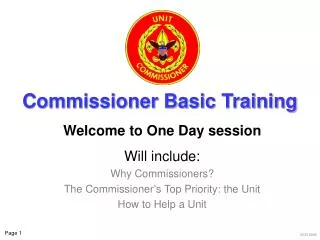
Commissioner Basic Training
Commissioner Basic Training. Welcome to One Day session Will include: Why Commissioners? The Commissioner’s Top Priority: the Unit How to Help a Unit. Commissioner Basic Training. Why Commissioners?. Session One. Learning Objectives. At the end of this session, you should be able to:.
1.08k views • 59 slides
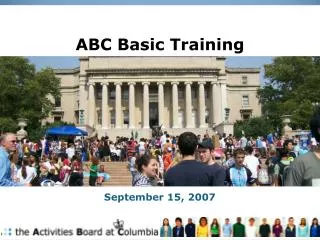
ABC Basic Training
ABC Basic Training. September 15, 2007. The Activities Board at Columbia. ABC is the largest of six governing boards at Columbia. There are currently 154 student groups under ABC.
493 views • 19 slides

AWARENESS TRAINING ON 5S PRACTICE
5S BACK GROUND. SINCE THE EARLY'80'SJAPANESE INDUSTRIES WIDELY PRACTISED 5S AS A POWERFULTECHNIQUE TOIMPROVE PRODUCTIVITY
2.4k views • 39 slides

1.59k views • 55 slides
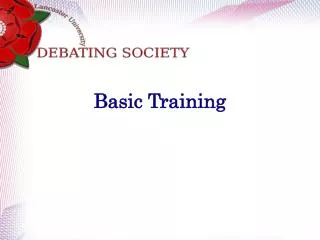
Basic Training
Basic Training. What is debating?. LUDS practice British parliamentary debate that is: A structured argument about a certain topic (motion) Between two sides and four teams. The proposition (Government) and the opposition.
503 views • 14 slides
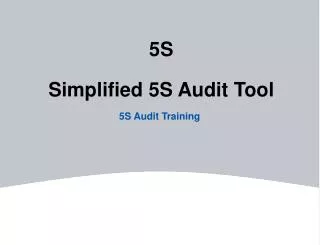
5S Simplified 5S Audit Tool
5S Simplified 5S Audit Tool . 5S Audit Training. 5S Levels Of Achievement. What Color (Level) is your area?. 5S Audit Form – Scores & Levels of Achievement. 5S Audit Tool: Using the same Chart for the 5S Audit Rating Chart & 5S Levels of Achievement Chart
2.87k views • 6 slides
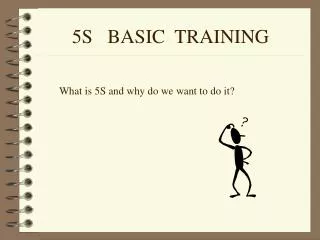
5S BASIC TRAINING
5S BASIC TRAINING. What is 5S and why do we want to do it? . What is 5S and why do we want to do it?. 5S is short for: Sort, Set in Order, Shine, Standardize and Sustain 5S represents 5 disciplines for maintaining a visual workplace (visual controls and information systems).
3.06k views • 15 slides
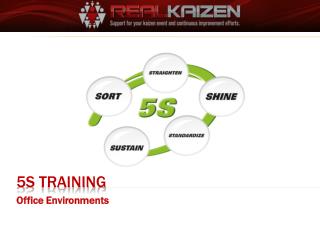
5S training
5S training. Office Environments. What is 5S?. 5S is a process for implementing and maintaining a clean, safe, and organized work area. 5S provides a way for organizations to operate efficiently and effectively.
2.31k views • 0 slides

BASIC TRAINING
BASIC TRAINING. Paradigma & sikap. Oleh : Novi Kurniawan ( Pengusaha Multimedia). Paradigma. Cara kita memandang sesuatu yang kemudian menjadi acuan berpikir , mengambil keputusan dan tindakan. Beda Paradigma , Beda Aksi … Apa yang Anda lihat ??? . Mengapa
2.26k views • 193 slides
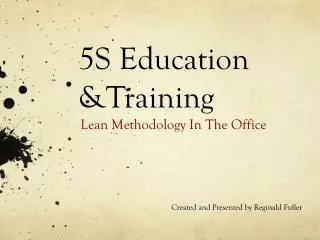
5S Education &Training
5S Education &Training. Lean Methodology In The Office Created and Presented by Reginald Fuller. Agenda. Welcome and Introduction Restrooms Breaks and Lunch Pagers and Cell Phones Questions Participation Remain Comfortable Lean Methodology and Waste The 5S System Conclusion.
2.85k views • 46 slides

Basic Training. 듣기. Evaluation. Task Completion Organization Fluency Delivery Language Usage. □ 숨기기 ( 인쇄 제외 ). Basic Training. Evaluation. Task Completion Organization
197 views • 7 slides

Iphones 5s. What are IPhone 5s. An IPhone 5 is technology of today. People use it all the time, maybe not all the time, but most of the time. How can this device be used in a classroom?.
313 views • 6 slides
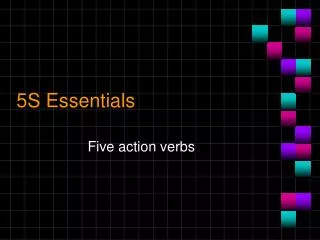
5S Essentials
5S Essentials . Five action verbs . Principle of 5 S. 5S Philosophy focuses on effective work place organization, simplifies work environment, reduces waste while improving quality and safety.
624 views • 13 slides

Basic Training. Getting Started. A free, unbiased service, sponsored by the Washington State Office of the Insurance Commissioner. Welcome to Basic. In the next two days you will be presented with an overview of the topics that you need to advise clients.
1.38k views • 103 slides

Basic Training. Update on Most Recent Pharmacy-Specific LTC Regulations Presented By: Martha M. Little, PharmD, Certified Geriatric Pharmacist Region IV Board of Directors, ASCP Director of Quality Improvement, Omnicare, Inc. Basic Training. Major medication-related F-Tags:
718 views • 53 slides

WELCOME TO. BASIC TRAINING. SOLDIER RESPONSIBILITIES AS A COLLEGE STUDENT. CSU. ARMY. COUGARNET. This is your communication tool to Columbus State University. CHECK COUGARNET OFTEN. CougarNet and GoArmyEd Do not work together!. Information sent to you regarding CSU information.
474 views • 23 slides

Basic Training. Clinical Risk Management In the Long Term Care Setting Jo Ann Fisher, MSN, FNP-C. Basic Training. Objectives List clinical areas of risk and strategies for managing risk for these areas. Define Quality Indicators Describe the role of the care plan as a communication tool.
307 views • 19 slides

Basic Training. Collaborative Practice in Long Term Care Setting Jo Ann Fisher, MSN, FNP-C. Basic Training. Objectives. Define the scope of practice of the NP/PA Describe the components of a collaborative agreement
252 views • 8 slides

BASIC Training
BASIC Training. OIMA: a Bible study method. Observation. Observation : What do I see ?. The Skill of Observation. Examples of Good Observations. Key Words Words that are repeated Therefore, but, so Structure Grammatical – Subject and verb of the passage.
622 views • 18 slides

Basic Training. Tile Laying System. MUREXIN AG / Michael Maier Version: Oktober 2007. Tile Laying System. Preparation. TLS - Preparation. Penetrating Primer LF. for absorbent substrates ready-to-use one component solvent free Consumption: appr. 0,15 kg/m² Delivery units: 1 and 5 kg
319 views • 18 slides

5S Methodology | What Is 5S Methodology? | 5S Methodology Explanation | Simplilearn
This presentation on 5S Methodology will take you through everything you need to know about the workplace organization method, 5S. This video also covers a number of different topics like the basics of the 5S methodology, its benefits and the process of 5S, like Sort, Set in order, Shine, Standardize, and Sustain. So now, let's jump in and learn about the 5S methodology. Learn to develop your organizational projects with the Lean Six Sigma Green Belt certification online program. Aligned to the IASSC exam, this online six sigma certification integrates lean and the DMAIC methodology with case studies to provide you the skills required for an organization's growth. About Simplilearn SIx Sigma green belt course: This Lean Six Sigma Green Belt course provides an overview of Six Sigma and the DMAIC methodology and is aligned to the leading Green Belt certifications at ASQ and IASSC. In this Lean Six Sigma Green Belt course, you will learn how to measure current performance to identify process issues and how to formulate solutions. Six Sigma Green Belt Training Key Features: - 56 hours of high-quality blended learning - 33 PDUs offered - 4 simulation test papers, 4 real-life projects - Aligned to ASQ and IASSC Eligibility: Lean Six Sigma professionals are in high demand due to their ability to use problem-solving techniques to reach business solutions and assuring quality control throughout the process. The Lean Six Sigma Green Belt certification is ideal for Quality system managers, Quality engineers, Quality supervisors, Quality analysts and managers, Quality auditors, and any individual wishing to improve quality and process within an organization. Learn more at https://www.simplilearn.com/quality-management/lean-six-sigma-green-belt-training
1.79k views • 59 slides
Lean Manufacturing Tools
Lean manufacturing tools, techniques and philosophy | lean and related business improvement ideas.

Free Lean Presentations
We can provide you with a full range of presentations in both PowerPoint PPTX format or PDF format for free download.
To Download simply Click on the Links Below:

Free Lean 5S Presentations
For a Full Range of free 5S presentations click here:
5S PDF and PPT
Presentations cover everything from red tags and the individual steps, through to planning your implementation of 5S
Free Value Stream Mapping Presentations
The following presentations are available for download and should be used in conjunction with the following pages on this site; how to create a VSM , and How to create your future state VSM .
VSM Presentations in PPT
How to Create a Value Stream Map pptx
Creating a Future State Value Stream Map pptx
VSM Presentation PDF
Creating a VSM PDF
Creating a Future State VSM PDF
Lean 7 Wastes Free Download
The following are available for free download:
Lean 7 Wastes PPT
7 Wastes of Lean Presentation
Lean 7 Wastes PDF
Seven Wastes PDF
Conditions of Use
- Any commercial use of these presentations and the content therein is prohibited without prior permission. Requests for permission to use can be made through the contact page: http://leanmanufacturingtools.org/contact-page/
- These presentations are for personal use only and cannot be reproduced or circulated by anyone other than www.leanmanufacturingtools.org
- Content may be quoted or reproduced for private and educational assignments as long as a proper citation is given referring to leanmanufacturingtools.org
- The information within these presentations and website are for information purposes only and any action taken is at your own risk.
- Collections
- Project management
5s Diagram Presentation Templates
Knock knock 5s method - “a place for everything and everything in its place.” 5s stands for sort, straighten, shine, standardize, sustain. go for it get our free 5s diagram powerpoint templates and google slides themes with colorful shades to match your company's brand. it's that easy.
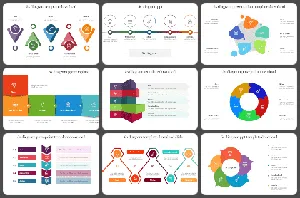
Craft Successful 5S Presentations with Our Ready-Made Free 5s Diagram PowerPoint Templates and Google Slides Themes!
Become an expert with slideegg.

How to Create a 5 Steps Infographic in PowerPoint

5s Diagram PowerPoint Presentation

We're here to help you!
What is the 5s diagram.
A 5s Diagram provides an overview of a process, station, or work area. It is a five-step methodology for making a more productive and organized workspace: Sort, Straighten, Shine, Standardize, and Sustain.
What are 5s Diagram PowerPoint Templates?
The 5s Diagram PowerPoint Templates can help to display growth and improvement strategies. It is an effective tool for communicating the five-step methodology.
Where can we use these 5s Diagram Slides?
5s Diagram Slides can be used in any work environment to present floor plans, flowcharts, and more.
How can I make 5s Diagram Slides in a presentation?
Find pre-designed templates from the internet and edit them with your own data to instantly make 5s Diagram Slides. Our tips and tricks will also help you learn how to make creative slides.
Who can use 5s Diagram PPT Templates?
Management professionals can use 5s Diagram PPT Templates to impressively present the five-step methodology.
Why do we need 5s Diagram PowerPoint Slides?
The 5s Diagram PowerPoint Slides can help you present information visually, which will help your target audience easily understand the concept.
Where can I find Free 5s Diagram PPT Templates?
Visit Slide Egg to find 27+ pre-designed professional-looking 5s Diagram PPT Templates.

IMAGES